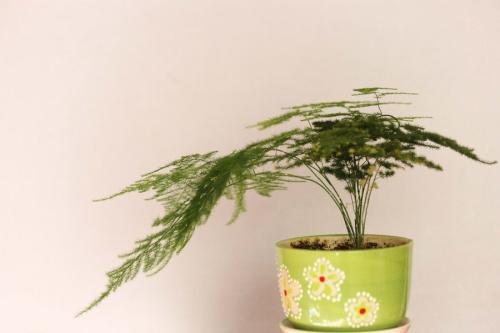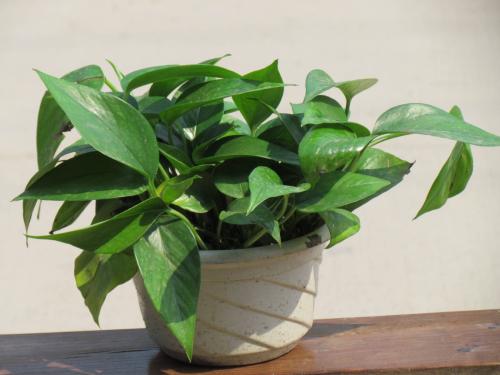What are the breeding methods and matters needing attention of asparagus? Diagram of salvation method for yellowing leaves of asparagus
In life, in order to make the indoor air fresher, many people will choose to put green plants at home, which can not only be beautiful but also play a role in purifying the air, while asparagus is graceful and elegant and chic. In addition, it is relatively short and suitable to be planted at home as a potted plant, so it is very popular!

Asparagus is a very high ornamental plant, which can be placed in the living room and study at home. The breeding method of asparagus is simple. From the propagation of asparagus, it can be divided into plant propagation and sowing reproduction.
1. Propagation of asparagus
A, ramet propagation
Asparagus is different from green apple, it can not be propagated by pinching a node from the stem, but must adopt the method of split propagation. In terms of the characteristics of asparagus, asparagus is very clustered, and new tillering seedlings will sprout at the rhizosphere of asparagus for more than 4 years, so as to make the plant grow.
B, sowing and reproduction
This is the main method of propagation of asparagus. After the pericarp of asparagus seed becomes black and soft, it is ripe, rubbed, cleaned and dried.
2. Temperature and environment
Asparagus is not very sensitive to temperature, generally above 10 degrees, frost injury will occur below 5 degrees, between 15 degrees and 25 degrees is the most suitable for asparagus growth, the temperature above 32 degrees will stop growing. When the weather is too cold in winter, you can put a layer of plastic film on the outside of the potted plant to keep warm.
In addition, the higher the air humidity, the better. In hot weather, often sprinkle water on the ground and leaves around plants to increase air humidity.
3. Soil requirements
Asparagus requires high drainage, it is best to choose humus-rich humus, peat soil and other loose and well-drained soil, a little base fertilizer can be added to the soil, which will be beneficial to the growth of plants.
Generally, it can be prepared with the proportion of 4 parts of garden soil, 2 parts of rotten leaf soil, 2 parts of compost soil and 1 part of sand, and the soil should be changed and fertilized regularly. If excessive fertilization causes "watering roots", it is necessary to pour the pot to remove the fertilizer, irrigate the soil with clean water, and then put it into the new soil for breeding.
4. Lighting
Asparagus likes semi-overcast environment, it is best to put it indoors with astigmatism, except in winter, other seasons should not be placed in the sun, especially in summer, because the sun is more poisonous, it will burn branches and leaves, generally speaking, if you want to be placed in the sun in spring, summer and autumn, it should be 60% shielded.
At the same time, asparagus flowering is not only afraid of wind, but also afraid of rain, should pay attention to good ventilation, good weather can be properly placed outside to receive sunlight. The temperature of potted asparagus in winter should be kept above 5 ℃ to avoid freezing.
5. Watering
Asparagus is a fleshy root, watering should be careful. Each watering should be thoroughly watered, not half of the water, so that the rhizome will not be able to absorb water and die. The amount of water should not be too much, not too little, and should be reasonably grasped. When the basin soil is slightly dry, it needs to be watered in time. It is necessary to "dry and water thoroughly". When the weather is hot and dry, water spraying can be used to humidify and cool the leaves, but less watering is needed in winter.
6. Display
Asparagus loves a clean and well-ventilated environment. If stimulated by harmful gases such as smoke, gas and pesticides, the leaves will turn yellow, curl and even die. Therefore, asparagus should be placed in a clean, well-ventilated environment, away from marble decorative materials that release mercury gas.
Matters needing attention in asparagus culture
1. Asparagus can not be cultured outdoors in northern winter, so asparagus should be moved indoors in time to provide a warm growing environment.
2. Asparagus can not be watered too frequently and can be kept moist by spraying water on the leaves. Spray water 1-2 times a day in summer and once every 3-4 days in winter.
3. Do not water directly with tap water. Should be placed 1-2 days in advance, release the chlorine in the water, etc., to ensure that the water temperature will not be too cold.
4. Thin fertilizer is applied once a week in spring and autumn, and compound flower fertilizer is best applied. Can not apply raw fertilizer, if you want to apply domestic fertilizer can be fully fermented and used.
5. Asparagus does not like smoke and dust. If you use a coal stove for heating in winter, you need to ensure proper ventilation.
6. Asparagus should be pruned in time. Too dense branches will affect ventilation and reduce ornamental value. If there are too many evil roots, we should divide the basin in time.
What if the leaves of asparagus turn yellow?
If the culture method is not correct, the yellowing of leaves will easily occur in the process of culturing asparagus, which will not only affect the ornamental effect, but also affect the growth of asparagus. When the leaves appear yellowing, now find out the cause of yellowing according to the situation of yellowing and save it in time.
1. Yellowing of leaves caused by improper watering
This is the most common reason for the yellowing of asparagus leaves. Asparagus is a wet plant. If it is watered too much, it will become waterlogged, which will cause the roots to rot and cause asparagus leaves to turn yellow, and the leaf yellowing area is larger, while less watering. It starts yellowing from the tip of the leaf.
Rescue method: if there is too much watering, you can not water temporarily, but only spray water to the leaves to moisturize asparagus. The standard is to water dry and thoroughly, but there is no stagnant water.
2. Yellowing of leaves caused by unsuitable temperature
Asparagus has a suitable temperature for its own growth, generally speaking, it is the most suitable between 12 and 18 ℃, especially in the northern winter when it is placed in a sunny position, because it is in a low room temperature for a long time, and its metabolism is slow due to freezing injury.
Rescue method: the temperature of asparagus culture in winter should not be lower than 12 ℃, and should be placed in a place with better light, watering can be reduced appropriately. If the temperature can not meet the requirements, plastic film can be used to make a simple greenhouse to help asparagus through the winter.
3. Yellowing of leaves caused by fertilization
This is easier to judge. Think about whether asparagus has been fertilized recently. If you apply too much fertilizer or too little fertilizer, it will cause some discomfort. If you use too much fertilizer, you will burn seedlings. If you use too little fertilizer, it will lead to subsequent undernutrition and yellowing of leaves.
Rescue method: if there is too much fertilizer, it is recommended to change the pot immediately and transplant asparagus to a new environment. Or water the plant immediately and move the plant to a place with bright light and good ventilation. If there is not enough fertilizer, it is recommended to increase the amount of chemical fertilizer to provide the nutrients needed by asparagus.
4. Yellowing of leaves caused by light problems
Asparagus likes a semi-overcast environment. If there is strong light, it will stimulate the leaf cells and cause chloroplast injury and yellowing.
Rescue method: move the flowerpot to a cool place, and spray more water to the branches and leaves to increase humidity, water evaporation will take away a certain amount of heat, can cool asparagus.
5. yellowing of leaves caused by diseases and insect pests
If all the above conditions are excluded, the yellowing of asparagus leaves may be caused by diseases and insect pests. Scale insects are the most common pest in asparagus culture. After giving birth to shell insects, if left unchecked, the nutrients of asparagus will be completely absorbed and the leaves will be yellowed.
Salvage methods:
When a shell worm is found, it should be wiped off with a wet cloth in time. When it is serious, you should buy it at the drugstore for prevention and control, and change the pot soil in time. When changing the pot soil, the old residual roots can be cut off to reduce nutrient consumption.
Time: 2019-05-05 Click:
- Prev

The effect of green radish breeding methods and precautions, green radish leaves yellow picture is what causes
Green radish is a common indoor decoration plant in the home. Green radish is green and evergreen all year round. Whether it is placed in the living room, study or hanging at home, this touch of green freshness can not only bring people a sense of aesthetic pleasure. And there are many other functions to purify the air
- Next

Sika deer breeding technology Daquan video course sika deer breeding cost profit and risk prospect market
Sika deer are rare and protected animals in the world. Affected by man-made hunting and destruction of natural environment, the number of wild sika deer in China is very rare. And we all know that the whole body of deer is covered with treasures, pilose antler and its by-products have the effect of health care, and have high medicinal economic value in the market.
Related
- Fuxing push coffee new agricultural production and marketing class: lack of small-scale processing plants
- Jujube rice field leisure farm deep ploughing Yilan for five years to create a space for organic food and play
- Nongyu Farm-A trial of organic papaya for brave women with advanced technology
- Four points for attention in the prevention and control of diseases and insect pests of edible fungi
- How to add nutrient solution to Edible Fungi
- Is there any good way to control edible fungus mites?
- Open Inoculation Technology of Edible Fungi
- Is there any clever way to use fertilizer for edible fungus in winter?
- What agents are used to kill the pathogens of edible fungi in the mushroom shed?
- Rapid drying of Edible Fungi

